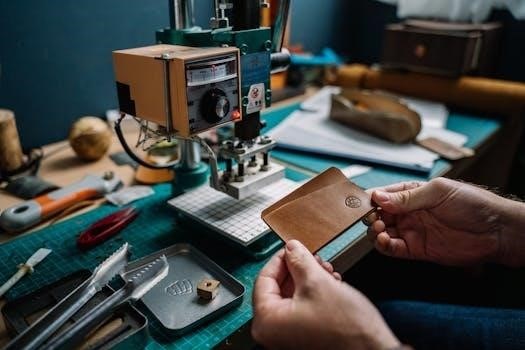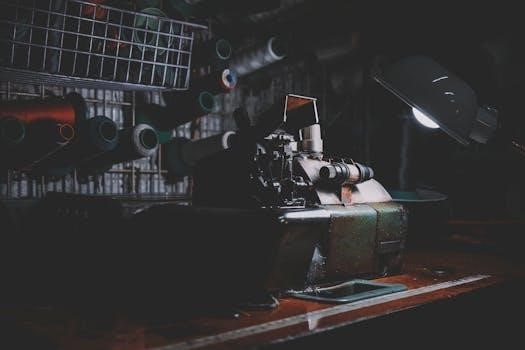Welcome! This guide provides a comprehensive overview of Singer sewing machines. Find manuals, understand models, and master basic operations. Learn about maintenance, troubleshooting, and accessing online resources for seamless sewing experiences.
Singer, founded by Issac Singer in 1850, stands as a leading brand in the sewing machine industry. With a legacy spanning over a century, Singer sewing machines have empowered countless individuals to create and express themselves through the art of sewing. Singer offers a diverse range of machines catering to all skill levels from beginners to experienced seamstresses.
Whether you’re a hobbyist or a professional, a Singer sewing machine provides the tools you need to bring your creative visions to life. From basic models like the Start 1304, ideal for beginners with its preset stitch length and width, to advanced machines with a wide array of stitches and features, Singer has something for everyone; Explore the world of sewing with a brand known for its quality, reliability, and innovation.
Understanding Your Singer Model
To maximize your sewing experience, it’s crucial to understand the specifics of your Singer sewing machine model. Each model boasts unique features, capabilities, and operational nuances that can significantly impact your projects. Locating your model number is the first step. This number is usually found on a sticker or plate located on the machine’s body, often near the base or back.
Once you’ve identified your model, consult the user manual. The manual provides detailed information on everything from threading the needle to selecting stitches and performing basic maintenance. With the model number, you can find manuals and updates online, which are often available for free download. Understanding your machine ensures optimal performance and longevity.

Getting Started
Ready to sew? This section covers the essentials⁚ identifying parts, threading the needle, and winding the bobbin. These initial steps are crucial for smooth, successful sewing projects with your Singer machine.
Identifying Parts of the Machine
Familiarizing yourself with the components of your Singer sewing machine is the first step toward confident sewing. Locate the power switch to turn the machine on/off. Identify the bobbin winder, essential for preparing the bobbin thread. Understand the function of the spool pin, which holds the thread spool during sewing. Recognize the presser foot lever used to raise and lower the presser foot. The needle clamp screw secures the needle in place. The stitch selection dial allows you to choose different stitch patterns. The reverse lever/button enables you to sew backwards for reinforcing seams.
The handwheel controls the up-and-down movement of the needle. Find the feed dogs responsible for moving fabric under the needle. The tension dial adjusts the thread tension for balanced stitches. Locate the take-up lever, which pulls thread from the spool; Lastly, familiarize yourself with the removable extension table, which provides a larger work surface.
Threading the Needle
Threading the needle correctly is crucial for smooth sewing. Begin by switching off the sewing machine for safety. Raise the presser foot to release tension on the thread. Place a spool of thread on the spool pin, ensuring it’s properly seated. Guide the thread through the thread guides, following the numbered diagram on your machine. Next, thread the tension discs to ensure proper thread tension.
Bring the thread down and around the take-up lever, making sure the lever is in its highest position. Guide the thread down towards the needle. Use the automatic needle threader (if equipped) or thread the needle manually from front to back. Pull a few inches of thread through the eye of the needle. Finally, position the thread under the presser foot, ready for sewing. Ensure the needle is fully up before beginning to avoid damage.
Winding the Bobbin
Winding the bobbin is essential to prepare for sewing. First, place the thread spool on the spool pin. Follow the thread path indicated on your sewing machine to guide the thread towards the bobbin winder. Next, place an empty bobbin onto the bobbin winder spindle. Wind the thread around the bobbin a few times to secure it. Push the bobbin winder spindle to the right to engage the winding mechanism.
Hold the thread tail while the bobbin winds a few layers. Then, trim the excess thread close to the bobbin. Depress the foot pedal to start winding the bobbin. Allow the bobbin to fill evenly, but not completely to the top. Once the bobbin is full, the winder will usually stop automatically. If not, disengage the bobbin winder manually. Remove the full bobbin and trim any remaining loose thread. Your bobbin is now ready for use!

Basic Operations
This section covers essential sewing tasks⁚ selecting stitches, adjusting stitch length and width, and understanding fabric and thread compatibility. Master these techniques for successful sewing projects.
Selecting Stitches
Singer sewing machines offer a variety of stitches, each suited for specific tasks. To select a stitch, consult your machine’s manual for its stitch selection mechanism, often a dial or electronic interface. Basic stitches include straight stitch, zigzag stitch, and buttonhole stitch. Decorative stitches can add embellishments to your projects.
Refer to your machine’s stitch guide for optimal settings. Consider the fabric type and project requirements when choosing a stitch. For example, a straight stitch is ideal for seams, while a zigzag stitch is suitable for finishing raw edges. Buttonhole stitches create professional-looking buttonholes.
Experiment with different stitches to understand their effects. Practice on scrap fabric before sewing your final project. With practice, you’ll become proficient in selecting the right stitch for any sewing task. Some machines even offer pre-programmed stitch combinations for added convenience. Always consult your manual!
Adjusting Stitch Length and Width
Fine-tuning your stitch length and width is crucial for achieving professional-looking results with your Singer sewing machine. Stitch length determines the distance between each stitch, while stitch width controls the side-to-side extent of zigzag or decorative stitches. Adjust these settings based on your fabric type and desired effect.
For delicate fabrics, use a shorter stitch length to prevent puckering. For thicker fabrics, increase the stitch length for better seam strength. Similarly, adjust the stitch width depending on the desired appearance of zigzag or decorative stitches. A wider stitch width creates a bolder look, while a narrower width offers a more subtle effect.
Consult your machine’s manual for specific instructions on adjusting stitch length and width. Most machines feature dials or buttons for easy adjustments. Always test your settings on scrap fabric before sewing your final project to ensure optimal results. Experimentation is key to mastering these adjustments!
Fabric and Thread Guide
Selecting the right fabric and thread is essential for successful sewing projects. Different fabrics require specific thread types and needle sizes to ensure proper stitching and prevent damage. Lightweight fabrics like silk or chiffon pair well with fine threads and needles, while heavier fabrics like denim or canvas require stronger threads and larger needles.
Consider the fiber content of your fabric when choosing your thread. Cotton fabrics work best with cotton or polyester thread, while synthetic fabrics are better suited to polyester or nylon thread. Match the thread color to your fabric for a seamless look, or choose a contrasting color for a decorative effect.
Always consult your Singer sewing machine manual for recommended fabric and thread pairings. Using the wrong combination can lead to skipped stitches, broken needles, or damaged fabric. Experiment with different combinations on scrap fabric to find the perfect match for your project.

Maintenance and Troubleshooting
Keep your Singer sewing machine running smoothly with proper maintenance. Address common issues quickly. Refer to manuals and online resources for expert support and solutions.
Cleaning and Oiling
Regular cleaning and oiling are essential for maintaining your Singer sewing machine’s performance and longevity. Dust, lint, and thread buildup can impede smooth operation and cause unnecessary wear. Before cleaning, always disconnect the machine from the power source to prevent electrical shock. Use a soft brush to remove lint from the bobbin area, feed dogs, and other accessible parts.
For oiling, refer to your machine’s manual for specific oiling points. Typically, these include the bobbin race, needle bar, and any other moving parts. Use only sewing machine oil, as other oils may damage the internal components. Apply a small drop of oil to each point and then run the machine briefly to distribute the oil.
After oiling, wipe away any excess oil to prevent it from staining your fabric. Consistent cleaning and oiling will ensure your Singer sewing machine operates smoothly and reliably for years. This also avoids potential issues!
Troubleshooting Common Issues
Encountering issues with your Singer sewing machine is common, but many can be resolved with simple troubleshooting. If the machine isn’t feeding fabric properly, check the feed dogs to ensure they are raised and free from lint. A broken needle can result from incorrect threading, using the wrong needle type for the fabric, or pulling the fabric while sewing. Re-thread the machine carefully, select the appropriate needle, and guide the fabric gently.
If the thread keeps breaking, ensure it’s correctly threaded through all guides and tension discs. Check for nicks or burrs on the needle and replace if necessary. Uneven stitches may indicate incorrect tension settings. Adjust the tension dial until the stitches are balanced.
If the machine is making unusual noises, it may need cleaning and oiling. Refer to the “Cleaning and Oiling” section for instructions. For more complex issues, consult your machine’s manual or seek assistance from a qualified technician to ensure that you handle your machine with care.

Downloading Manuals and Updates
Accessing manuals and updates is now easier than ever. Singer provides online resources for downloading user manuals, stitch guides, and machine updates, ensuring you always have the latest information.
Finding Manuals Online
Lost your Singer sewing machine manual? Don’t worry, finding it online is simple. Singer, in line with the Green Initiative, offers manuals and updates exclusively online. Visit the official Singer website and navigate to the “Manuals and Updates” page. You can search by model number to quickly locate the correct manual for your machine.
Many third-party websites also host Singer sewing machine manuals, including older models. Be sure to verify the source’s credibility before downloading. Websites like ManualsLib offer a wide selection of manuals. Some websites offer professionally bound hard copies for purchase.
Remember, having the correct manual is crucial for understanding your machine’s features, troubleshooting issues, and ensuring its longevity. With online access, you can quickly get back to creating!